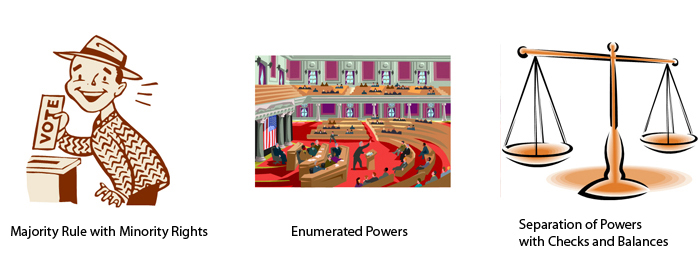
The U.S. Constitution establishes a representative government in which the people make the laws through lawmakers they have elected—either directly or indirectly (click here for explanation). This is majority rule, or popular sovereignty.
However, the Framers were concerned with tyranny of every kind, including a “tyranny of the majority.” They were afraid that if 51% of the population agreed on something, they could oppress the other 49% through majority rule. Therefore, the Constitution also has a Bill of Rights, the first ten amendments to the Constitution, that protects the rights of the minority.
However, the Framers were concerned with tyranny of every kind, including a “tyranny of the majority.” They were afraid that if 51% of the population agreed on something, they could oppress the other 49% through majority rule. Therefore, the Constitution also has a Bill of Rights, the first ten amendments to the Constitution, that protects the rights of the minority.
The Framers tried to be clear about what the federal government could and could not do. Article I of the Constitution sets up the legislative branch, which makes the laws. Section 8 of Article I lists the powers of Congress, including things such as the power to lay and collect taxes, raise an army and navy, build roads, establish post offices, and grant patents for inventions, among other things.
The Constitution also limits Congress. Article I, Section 9 specifically denies power to Congress. For example, Congress cannot grant titles of nobility or pass an ex post facto law, which is a law that applies to actions that occurred prior to its passing. The Bill of Rights also limits the power of Congress. The first amendment, which protects the freedom of religion, speech, assembly, the press, and to petition the government, begins with the words “Congress shall make no law.” In other words, Congress can’t do this.
The Constitution also limits Congress. Article I, Section 9 specifically denies power to Congress. For example, Congress cannot grant titles of nobility or pass an ex post facto law, which is a law that applies to actions that occurred prior to its passing. The Bill of Rights also limits the power of Congress. The first amendment, which protects the freedom of religion, speech, assembly, the press, and to petition the government, begins with the words “Congress shall make no law.” In other words, Congress can’t do this.
Lastly the Constitution prevents tyranny by creating three independent branches of government—the legislative, executive, and judicial branches. Each part of government has its own job. The legislative branch (Congress) makes the laws. The executive branch (President) enforces the law. The judicial branch (Supreme Court) interprets the law, or says what the laws mean. Three branches means one part of the government cannot get too powerful.
As a further guarantee that one branch cannot get too powerful, the Constitution goes one step further and has some powers overlap. For most actions of government, one branch can stop the other. For example, Congress makes the laws. However, the President can veto a law, or reject it. The Supreme Court can declare that a law violates the Constitution. Also, the President is the commander-in-chief of the military, but Congress decides when the United States goes to war.
As a further guarantee that one branch cannot get too powerful, the Constitution goes one step further and has some powers overlap. For most actions of government, one branch can stop the other. For example, Congress makes the laws. However, the President can veto a law, or reject it. The Supreme Court can declare that a law violates the Constitution. Also, the President is the commander-in-chief of the military, but Congress decides when the United States goes to war.